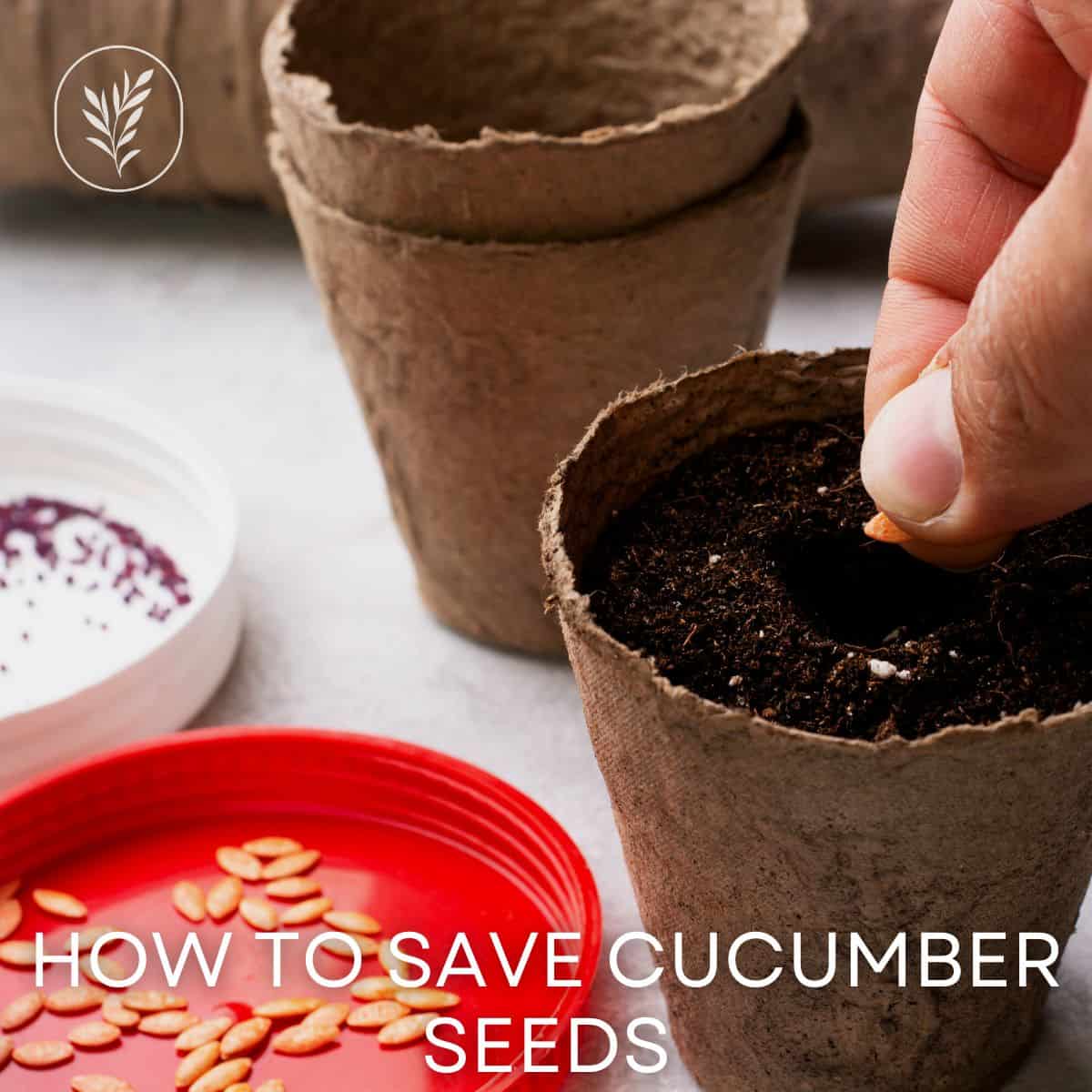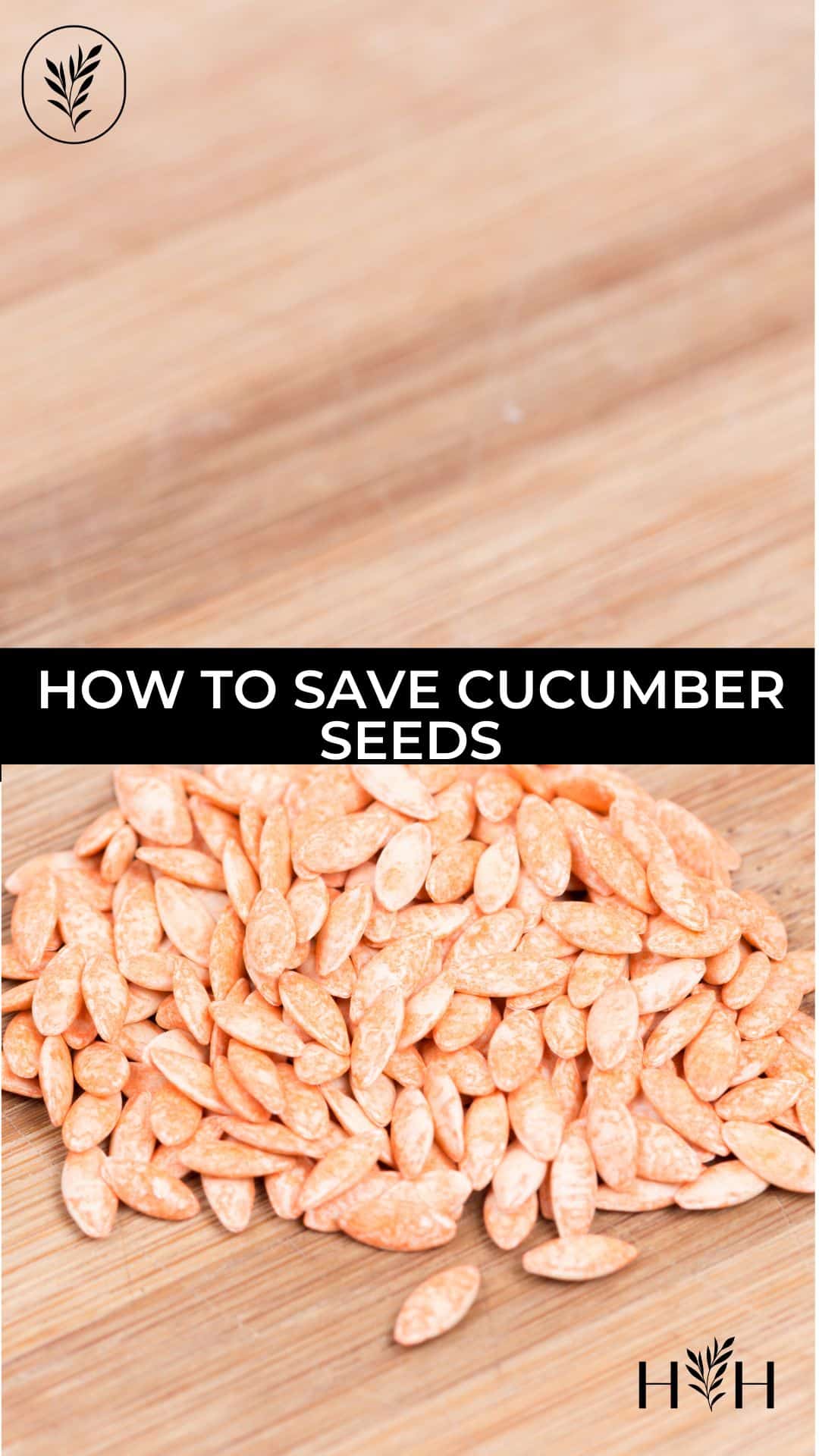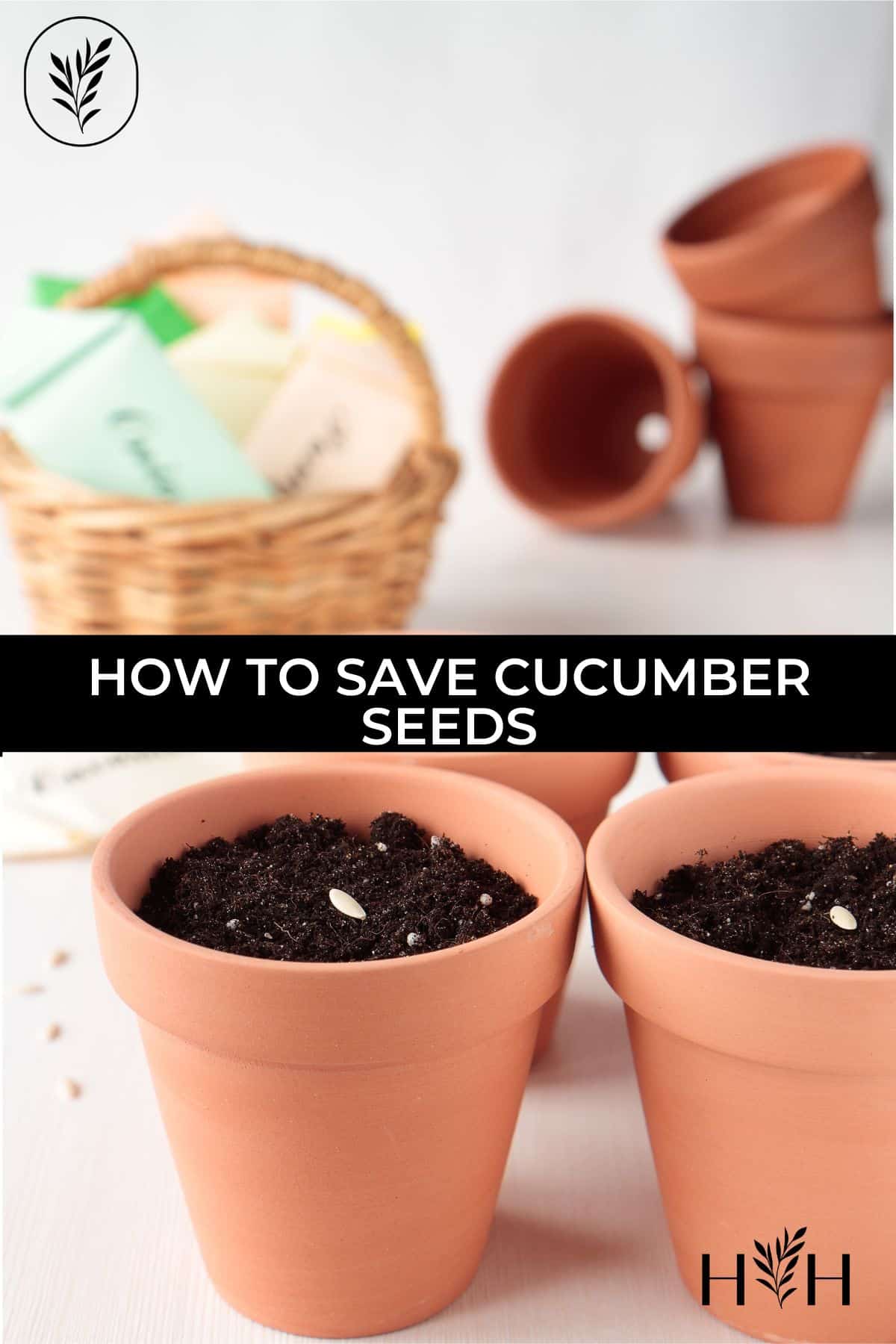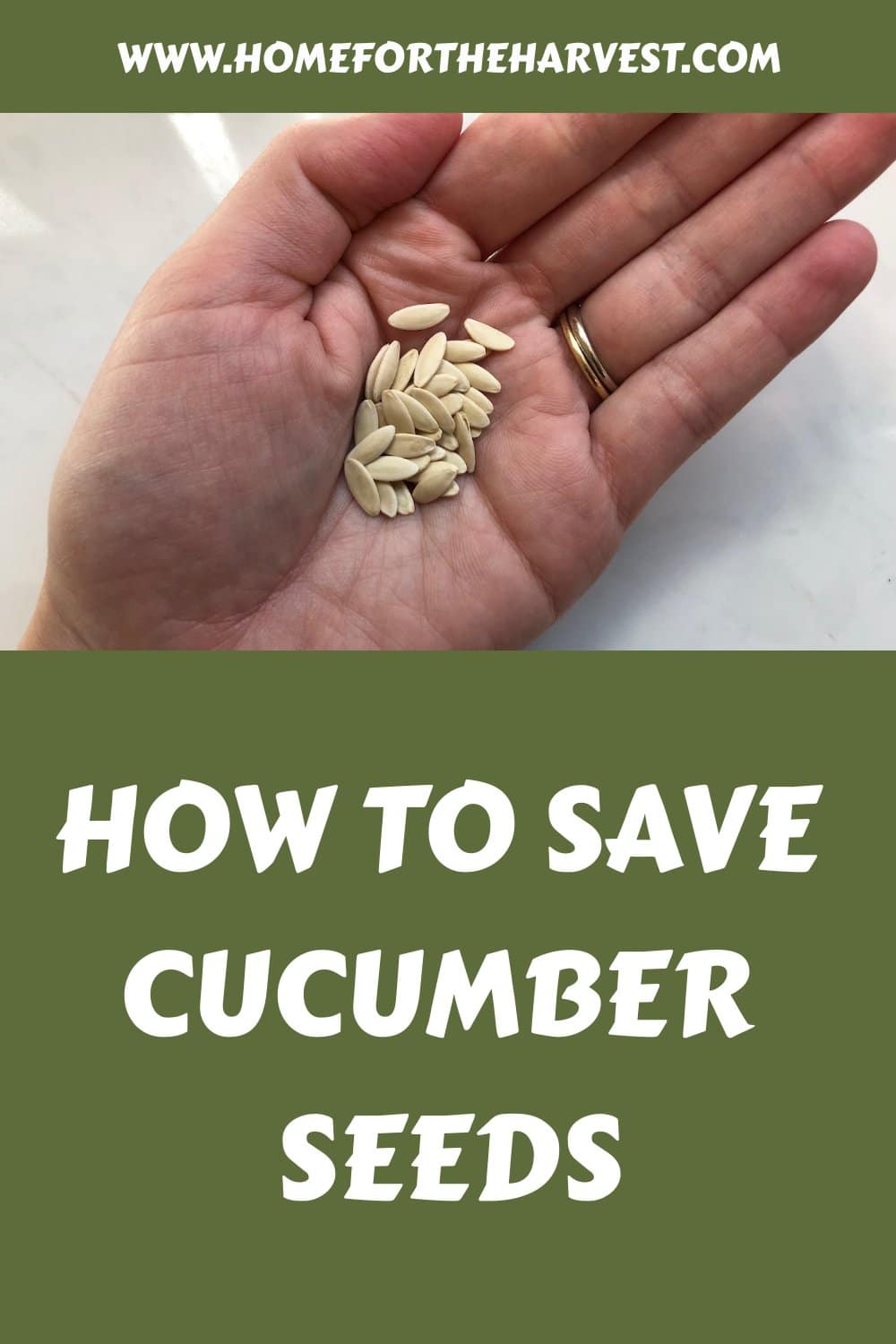What is the best way to save cucumber seeds? While cucumbers may appear difficult to save seeds, they are quite simple (if not a bit yucky).
To save cucumber seeds, first, wait until the cucumbers are rotten. After that, slice lengthwise and scoop out the seeds and juice from the lengthy seed cavities. Then transfer them to a jar with a bit of water. Stir a few times per day for 1-2 days until the gelatinous coating has dissolved. Then wash the seeds in a fine-mesh sieve under clean water and place them out to dry for a day or two before packaging them for storage.
Read on to learn all about how to save cucumber seeds!
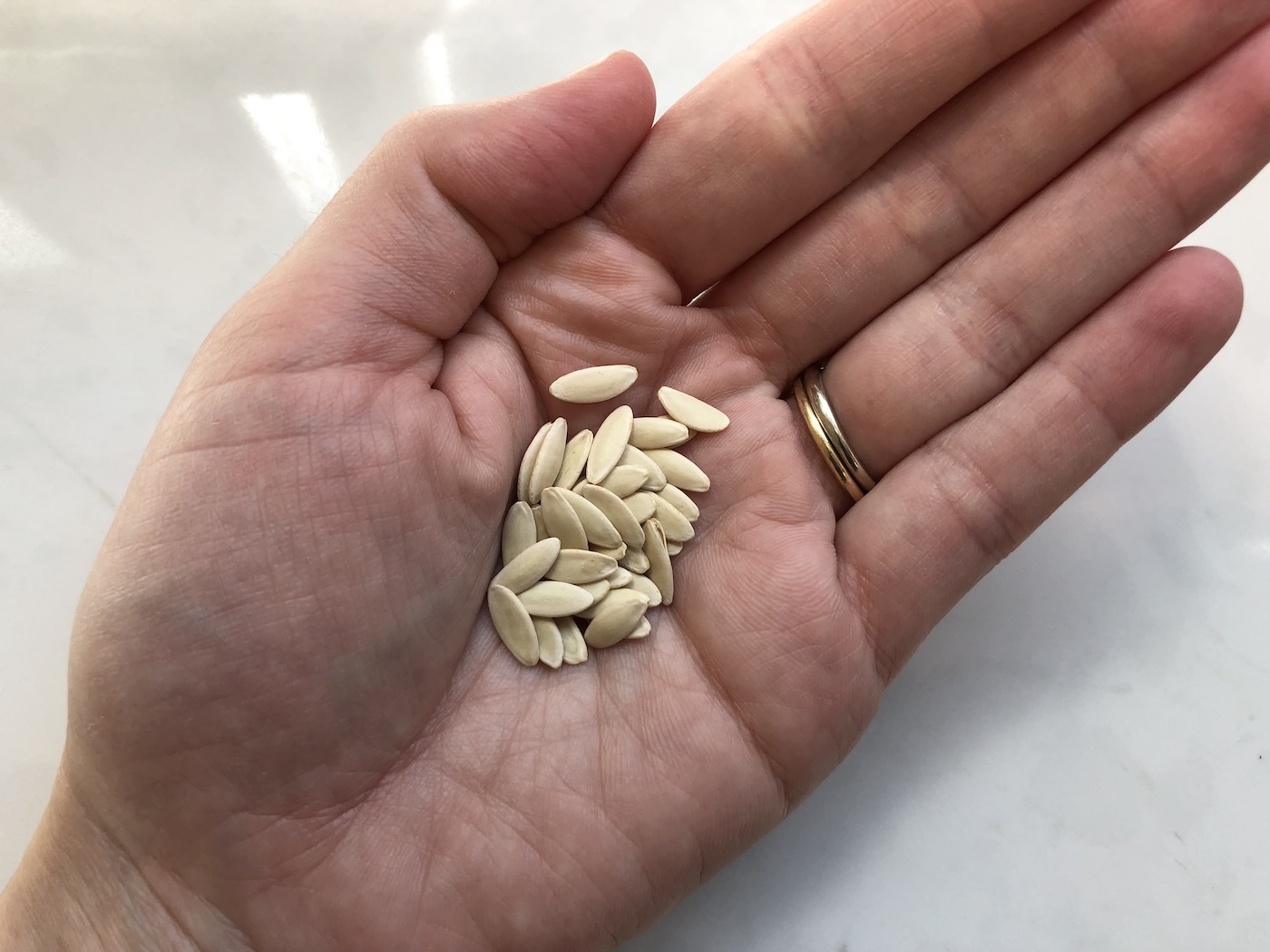
Introduction to saving cucumber seeds
Cucumber seeds are not the easiest vegetable seeds to save (that likely goes to peppers), but the process is more than worth it! Each cucumber has hundreds of seeds, meaning a little bit of work goes a long way.
You can save cucumber seeds from any open-pollinated varieties. This includes favorites like Marketmore and Parisian Gherkin Cucumbers. Saving cucumber seeds is a great project for kids, as they will likely not have seen properly ripe cucumbers since we eat them when the fruits are immature.
Most cucumber varieties that are open-pollinated (not hybrids) have both male and female flowers on a single plant. The plants are self-compatible, so male flowers from one plant can pollinate the female flowers on the plant. Like pumpkins, the vines first produce lots of male flowers to attract pollinators before starting to include female flowers in the mix. Cucumber flowers are most commonly pollinated by bees, which love the bright yellow blooms.
Cucumber seeds are prepared for storage using wet fermentation (like saving tomato seeds). Fermenting the seeds removes the gelatinous coating around each cucumber seed, so they are ready to germinate when planted in the spring. The gelatinous sack around the seed keeps the seed from germinating too early inside the cucumber in nature but can continue to inhibit germination if not removed before planting.
Planting cucumber for seed saving
To begin, you’ll need to produce some delicious cucumbers! To keep genetic diversity in your cucumber seedlings, start by planting at least six of the same type. Twelve or more plants for seed harvest are ideal if possible. Grow 25 plants or more to preserve genetic variation.
Choose an open-pollinated variety
Check that you’ve got the proper type of cucumber: open-pollinated. You can get heirloom or non-heirloom (newer) varieties as long as they aren’t hybrids (F1 crosses).
Here are some great open-pollinated cucumber varieties for seed saving:
- Marketmore Cucumber
- Muncher Cucumber
- Boston Pickling Cucumber
- Parisian Pickling Cucumber
- Mexican Sour Gherkin Cucumber (Cucamelon)
- Lemon Cuke Cucumber
Save seeds from only the most delicious cucumbers, so your next crop is extra yummy! Heirloom seeds are improved incrementally by generations of seed savers, preserving and enhancing them for future generations.
Isolation between varieties
Cucumbers for seed saving of a specific variety should be kept apart from other cucumber plants. Simply by planting them far away from other types or putting a physical barrier between varieties, you may prevent the variety you’re saving from interacting and crossing with others. You may wish to let your cucumber varieties cross-pollinate as you do your own backyard breeding.
Cucumbers of different varieties need to be grown a minimum of 500 feet (150 m) away from other cucumber varieties. Because this distance is so great, many seed savers choose instead to use isolation netting to keep out pollinators that might cross-pollinate the blossoms.
Row cover, in most cases, is used for isolation. Cucumber plants may be grown in polytunnels, greenhouses, or hoop houses with insect netting draped over them. Ensure the fly netting is securely fastened to the ground and around the edges to keep bumblebees, mason bees, flies, and other pollinators from getting in. Alternatively, use small silk or mesh bags over top of the flower buds to keep insects away when the flowers bloom.
Cucumber flowers are self-pollinated, meaning the pollen from a plant’s male flowers can pollinate the same plant’s female flowers (which become cucumbers). However, even though cucumbers are usually self-fertile, it’s a good idea to allow them to cross with other varieties (outcrossing) every few years. This will keep your plants’ genetic material fresh and will help prevent inbreeding depression.
Companion planting for seed saving
Consider planting a number of flowers around the garden to assist you with saving seeds. These blooms are intended to divert pollinating insects and keep them occupied.
We want the bumblebees to visit other plants rather than inadvertently transporting nectar from one cucumber variety to another. You may also consider planting a tall hedge-like crop like corn or pole beans on a trellis between varieties. Here are some great companion plants for cucumbers.
Growing cucumbers for seed saving
Keep your newly-installed cucumber plants healthy by providing them with regular water and removing any diseased leaves. You’ll also want to apply some slow-release organic fertilizer and mulch the soil’s surface to keep the roots cool and maintain moisture in the ground.
Watch for the first male and female flower buds to appear. Isolate the flower by putting a mesh bag over the buds. When they open, use a small paintbrush to transfer pollen from the male flowers (with the straight thin stem) to the female flowers (with the oval unpollinated fruit at the base). This is called hand-pollination and ensures that your plants are pollinated by the cucumbers you want them to be.
Cucumber fruits will mature in 50–70 days after planting, depending on the variety. Once they reach full size, allow them to remain on the vine for an extra week or two to allow the seeds inside to mature.
Choosing cucumbers to save seeds from
Harvest cucumber seeds from the first few fruits off the plant. If you have more than 12 plants, harvest only the middle of the patch’s plants to decrease the likelihood of cross-pollinated seeds. Just be sure to harvest cucumbers from a minimum of six plants. For genetic preservation, save seeds from 25+ different plants.
Look for healthy, uniform plants that are in their early flowering stage and have produced a lot of flowers/fruit to save your own cucumber seeds. In the vegetable garden, avoid harvesting cucumbers from sick, afflicted, or weak plants. To save your own seeds, try to pick healthy, uniform plants with many blooms/ fruit.
Harvesting cucumbers for seed saving
The cucumbers should be overly ripe when harvested. The cucumbers we eat are immature fruits, not ripe ones. Even if your cucumbers are quite ripe when picked, you usually harvest cucumber seeds from truly rotten cucumbers. Leave them on the vine until the outer rind gets hard and turns a yellow/orange/brown tone.
“Cucumber varieties with white spines turn pale yellow when mature, while the rinds of black-spined varieties will take on a deep-orange color (see also ‘Why Are Your Cucumber Leaves Turning Yellow?‘). It is best to wait several weeks after this color change before extracting the seeds.”
The Seed Garden: The Art and Practice of Seed Saving, by Micaela Colley and Jared Zystro
Try to pick the ripe fruit from within the center of the best plants, where the flowers were likely more susceptible to cross-pollination. When the cucumber is overly ripe (usually yellow or orange in color), bring it into a garage or another dry spot for it to continue ripening. It may be at least a month before the cucumber is ready for seed saving.
It also makes sense to harvest some extra cucumbers to put out to ripen to full maturity. Sometimes fruit set in cold conditions or with certain genetic traits will fail to set viable seeds or will only have a few seeds. If this happens, its good to have some extra overripe cucumber fruits to collect mature seeds from.
How to save cucumber seeds?
Slice the overripe cucumbers longwise when saving seeds. Scoop out the seeds and gel-like pulp substance into a glass jar (or cup or bowl). Add some water to the bowl and mix the pulp and seeds around gently with your fingers. Cover using an elastic with a cloth, paper towel, paper plate, or coffee filter.
Fermenting cucumber seeds
Set the jar of wet cucumber seeds on the counter. Fermentation will occur naturally and start to dissolve the gelatinous layer from around the seeds. Dissolving the layer completely usually takes only a day or two.
Stir the seeds a few times a day to prevent a thick layer of mold from growing on top of the seeds. Each time you stir, pull out a few seeds and see if they still feel slippery (meaning there is some gel remaining).
Cleaning the seeds
Wash the seeds in clean water once the cucumber seed gel has dissolved. You can also add some more fresh water to the jar of clean seeds and swirl it around. The viable seeds will sink to the bottom of the bowl while the pulp and other matter will float to the top.
Drying cucumber seeds
The seeds must now be quickly dried. While the seeds are in the sieve, allow the remaining water to drain off. Then, on a plate, paper towel, or coffee filter, place the seeds in small groups to dry. Large quantities dry well on old window screens.
To dry, place the seeds in a warm, well-ventilated location. Saving seeds well depends upon getting the moisture down to optimal internal levels. To speed up the drying process, keep the air temperature under 70°F (21°C). Cucumbers’ seeds are usually dry in a day or two but may take three days if the air is a bit humid.
Storing cucumber seeds
Once your seeds are completely dry, store them in a cool, dry place in a labeled envelope, baggie, or airtight container for seed storage. Be sure to label the container with the name of the cucumber variety and the date saved. Cucumber seeds have a long seed life and can last for 5-10 years when properly stored.


